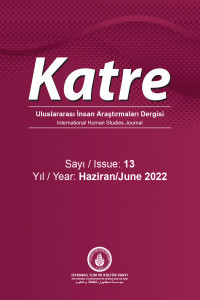Combination of Scientific and Religious Worldviews in the Works of Christian and Muslim Thinkers of the 20th Century
Dünya Görüşü, Bilim, Aydınlanma, Dünyevilik, İlahiyat
Combination of Scientific and Religious Worldviews in the Works of Christian and Muslim Thinkers of the 20th Century
worldview, science, Enlightenment, secularism, theology,
___
- Berlin, I. 1999. “The Purpose of Philosophy” In Concepts and Categories: Philosophical essays, 1-11. London: Pimlico.
- Embong, R. 2017. “Integrated Education as a Solution for Educational Dualism from Said Nursi’s Perspective”. PEOPLE: International Journal of Social Sciences Volume 3 Issue 2: 914-928.
- Habermas, J. 2006. “Secularization as a twofold and complementary learning process” In Ratzinger, J., and Habermas, J. Dialectics of Secularization: On Reason and Religion, 43-47. San Francisco: Ignatius Press.
- Kepel, Gilles. 1994. The revenge of God: the resurgence of Islam, Christianity, and Judaism in the modern world. University Park: Pennsylvania State University Press.
- Markham, Ian and Suendam Birinci Pirim. 2011. An Introduction to Said Nursi: Life, Thought and Writings. Farnham: Ashgate Publishing Limited.
- Teilhard de Chardin, P. 2002. “Christ the Evolver” In Christianity and Evolution, 138-150. Orlando: Harvest.
- Vahide, Sukran. 2019. Bediuzzaman Said Nursi: Author of the Risale-i Nur. Kuala Lumpur: Islamic Book Trust.
- Barbour, I. 2000. Religion and Science. Historical and Contemporary Issues. Moscow: BBI.
- Gaidenko, P. 1997. “Christianity and Genesis of Modern EuropeanNatural Sciences” In Philosophical-Religious Issues of the Science, 44-87. Moscow: Martis.
- Markova, L. 1999. “Theology in the postmodern era”. Philosophy questions № 2: 109-127.
- Eckartshausen, K. 1993. Key to the Mysteries of Nature. Tashkent: Shark.
- ISSN: 2146-8117
- Yayın Aralığı: Yılda 2 Sayı
- Başlangıç: 2016
- Yayıncı: İstanbul İlim ve Kültür Vakfı
İslam Kamu Mali Yönetimi ve Politikasında Dışlama Etkisi
The Problem of Evil in Ibn-i Sina and Said Nursî
Hikmet-i Teşrîʿ Açısından Miras Paylarıyla İlgili Bazı Hükümlerin Yorumlanması
Bediüzzaman'ın Osmanlı Devleti ve Bazı Padişahlar Hakkındaki Görüşleri
Ella BYSTRYTSKA, Ruslan KHALİKOV
Klasik Arap Edebiyatındaki “Sakil” Tipine Didaktik Bir Bakış
Doç.Dr. Ali Kuyaksil'in Ardından
